This year’s 2017 Wildlife Photographer of the Year competition presents a cast of natural world stars, showing an astonishing diversity of life on our planet and reminding us of the crucial need to shape a more sustainable future.
The world-renowned exhibition has run for the last 53 years and has attracted almost 50,000 entries from professionals and amateurs across 92 countries.
The event showcases world’s best nature photography and photojournalism on one global platform — igniting curiosity about the natural world while shining the spotlight on wildlife photography as an art form.
The exhibition opens on 20 October at the Natural History Museum in London. The overall winners will be announced on 17 October at an awards ceremony at the Natural History Museum’s stunning Hintze Hall. Winning images are selected for their creativity, originality and technical excellence,
Here are some of our favourites.
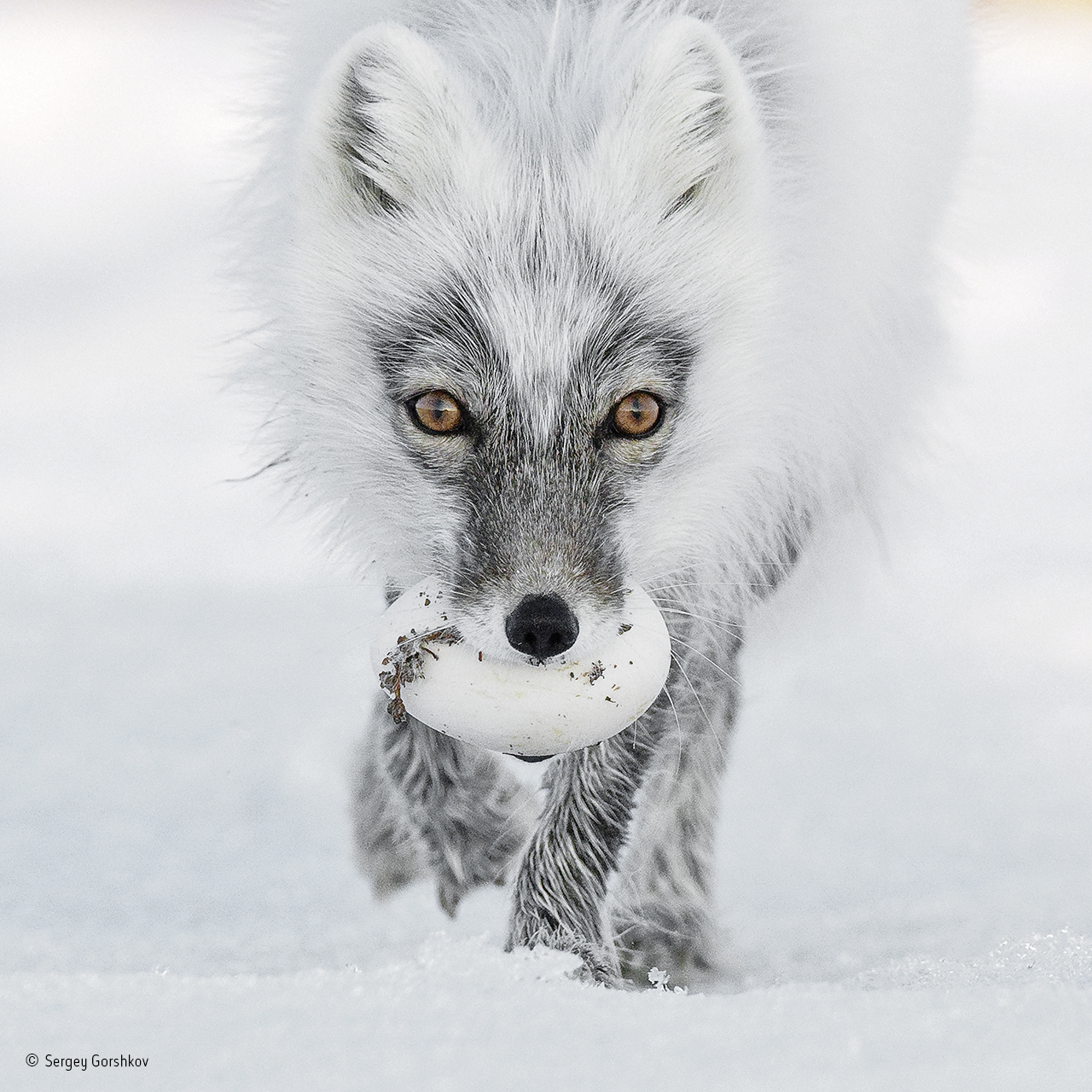
Arctic treasure
Photographer: Sergey Gorshkov, Russia
Finalist 2017, Animal Portraits
Carrying its trophy from a raid on a snow goose nest, an Arctic fox heads for a suitable burial spot. This is June and bonanza time for the foxes of Wrangel Island in the Russian Far East. Lemmings are the basic diet for Arctic foxes, but Wrangel suffers long, harsh winters and is ice‑bound for much of the year, making it a permanent source of stored food for these opportunist animals. The food convoys arrive at the end of May. Over just a few days, vast flocks of snow geese descend on the tundra of this remote UNESCO World Heritage Site, travelling from wintering grounds some 4,800 kilometres (3,000miles) away in British Columbia and California. Not only is this the biggest breeding colony of snow geese in the world, and the only remaining one in Asia, butit is also growing: from 160,000 geese in 2011 to about 300,000 by 2016. TheArctic foxes catch any weak or sick birds, but what they feast on are the goose eggs, laid in early June in open nests on the tundra. Though the pairs of snow geese actively defend their nests, a fox may still manage to steal up to 40eggs a day, harassing the geese until there’s a chance to nip in and grab an egg. Most of the eggs are then cached, buried in shallow holes in the tundra, where thesoil stays as cold as a refrigerator. These eggs will remain edible long after the brief Arctic summer is over and the geese have migrated south again. Andwhen the new generation of young foxes begins to explore, they too will benefit from the hidden treasures.
Equioment: Nikon D300S + 600mm f4 lens; 1/1250 sec at f5; ISO 800; Gitzo tripod + Wimberley head.
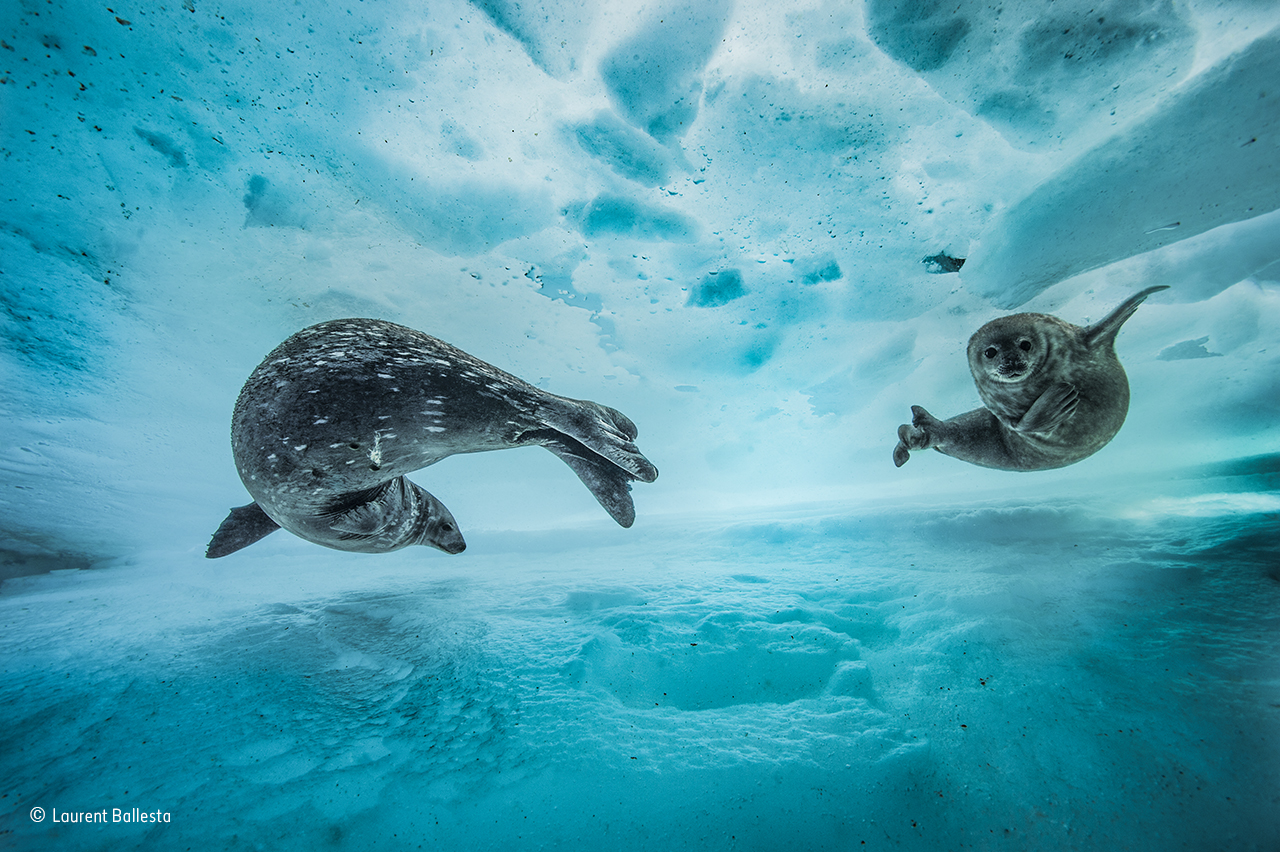
Swim gym
Photographer: Laurent Ballesta, France
Finalist 2017, Behaviour: Mammals
‘We were still a few metres from the surface, when I heard the strange noises,’ says Laurent. Suspecting Weddell seals –known for their repertoire of at least 34 different underwater call types –he approached slowly. It was early spring in east Antarctica, and a mother was introducing her pup to the icy water. Theworld’s most southerly breeding mammal, a Weddell seal gives birth on the ice and takes her pup swimming after a week or two. The pair, unbothered by Laurent’s presence, slid effortlessly between the sheets of the frozen labyrinth. Adults are accomplished divers, reaching depths of more than 600 metres (1,970 feet) and submerging for up to 82 minutes. ‘They looked so at ease, where I felt so inappropriate,’ says Laurent. Relying on light throughthe ice above, he captured the curious gaze of the pup, the arc of its body mirroring that of its watchful mother.
Equipment: Nikon D4S + 17–35mm f2.8 lens; 1/640 sec at f11; ISO 200; Seacam housing.
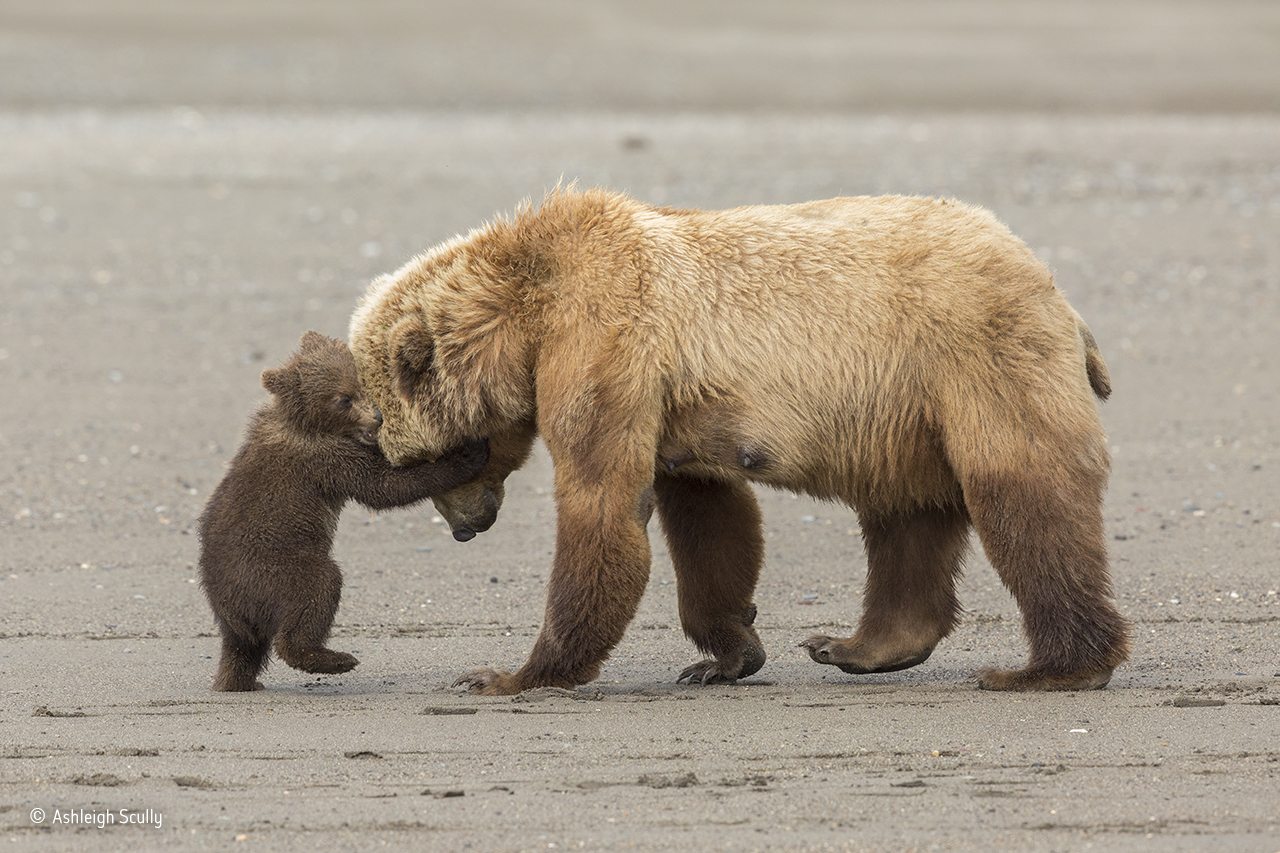
Bear hug
Photographer: Ashleigh Scully, USA
Finalist 2017, Young Wildlife Photographer of the Year, 11–14 Years
After fishing for clams at low tide, this mother brown bear was leading her young spring cubs back across the beach to the nearby meadow. But one young cub just wanted to stay and play. It was the moment Ashleigh had been waiting for. She had cometo Alaska’s Lake Clark National Park intent on photographing the family life of brown bears. This rich estuary environment provides a buffet for bears: grasses in the meadows, salmon in the river and clams on the shore. A large number of families spend their summers here, and with plentiful food, they are tolerant of each other (though wary of males) and of people. ‘I fell in love with brown bears,’ says Ashleigh, ‘and their personalities… This young cub seemed to think that it was big enough to wrestle mum to the sand. As always, she played along, firm, but patient.’ The result is a cameo of brown bear family life.
Equipment: Canon EOS 5D + 500mm f4 Mark II lens; 1/1250 sec at f8 (+1 e/v); ISO 1250; Gitzo tripod.
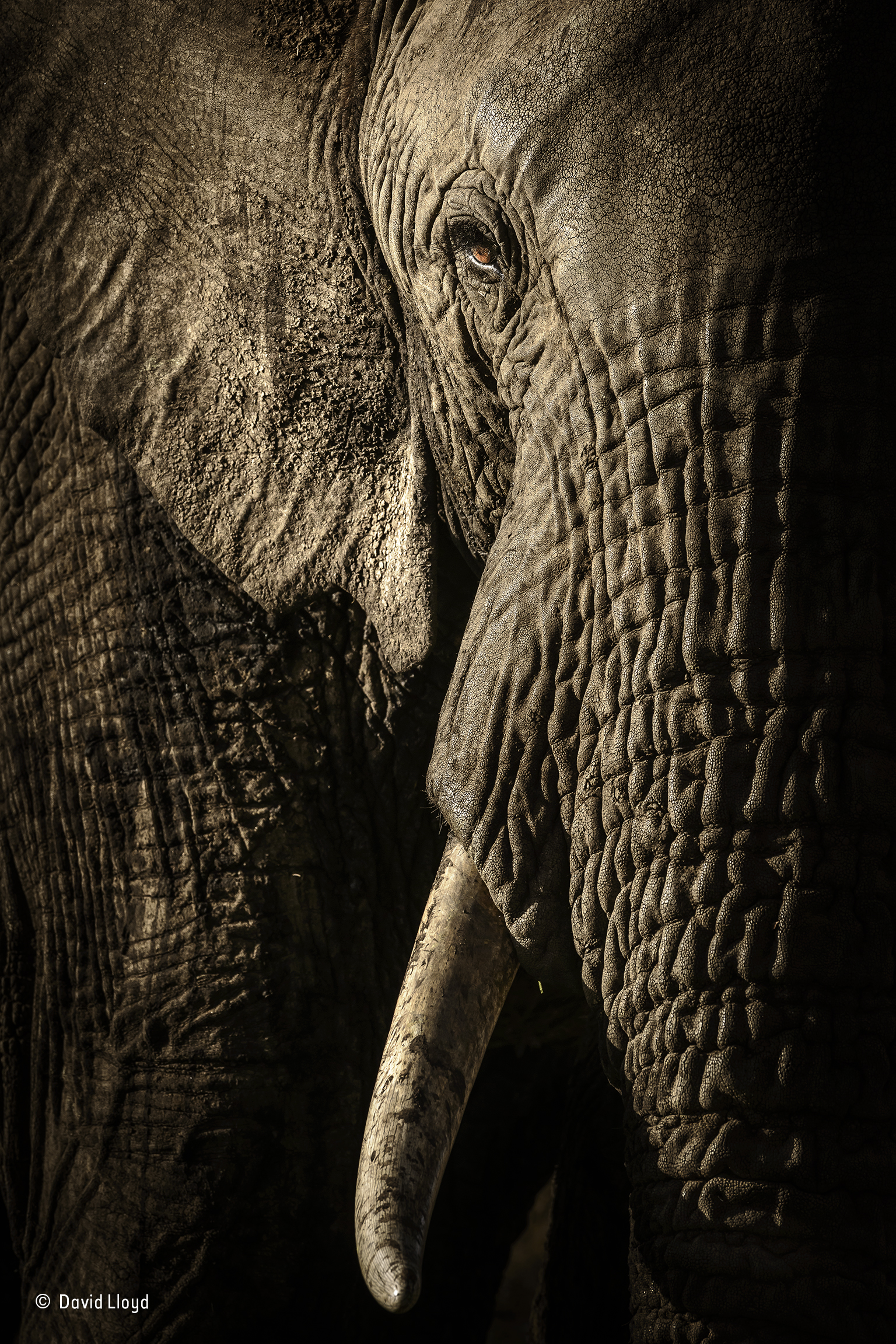
The power of the matriarch
Photograoher: David Lloyd, New Zealand/UK
Finalist 2017, Animal Portraits
At dusk, in Kenya’s Maasai Mara National Reserve, David waited for the herd of elephants on their evening trek to a waterhole. As they got closer to his vehicle, he could see that the mellow light from the fast-setting sun was emphasizing every wrinkle andhair. For a photographer who enjoys working with texture, this was a gift. When they were just a few metres away, he could see the different qualities of different parts of their bodies –the deep ridges of their trunks, the mud-caked ears and the patina of dried dirt on their tusks. Theelephants ambled by in near silence, peaceful and relaxed. The female leading the dozen-strong herd –probably the matriarch –looked straight at him, her eye a glowing amber dot in the heavy folds of skin. Hergaze was, hesays, full of respect and intelligence –the essence of sentience.
Equipment: Nikon D800E + 400mm f2.8 lens; 1/500 sec at f13 (–0.3 e/v); ISO 1000.
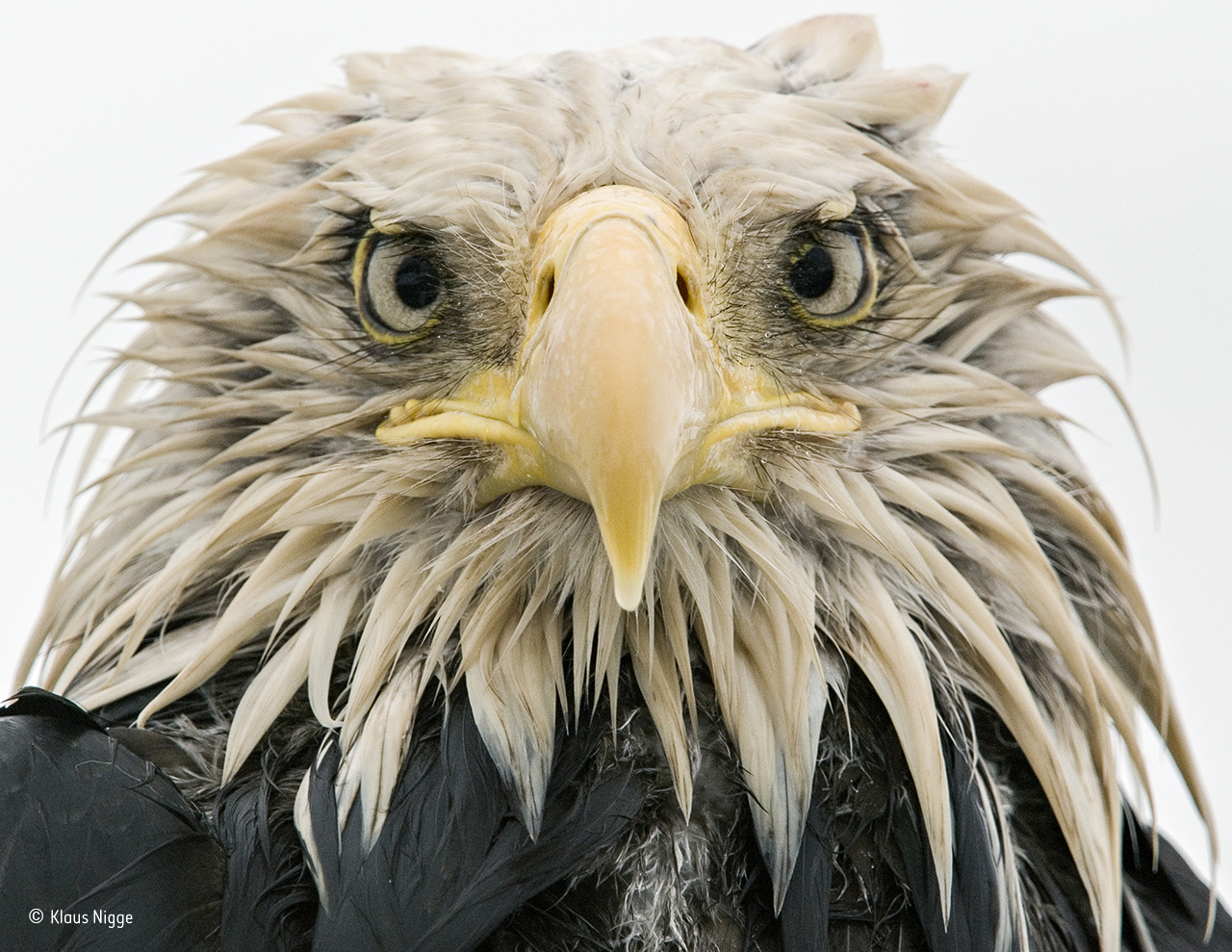
Bold eagle
Photographer: Klaus Nigge, Germany
Finalist 2017, Animal Portraits
After several days of constant rain, the bald eagle was soaked to the skin. Named after its conspicuous but fully-feathered white head (bald derives from an old word for white), it is an opportunist, eating various prey –captured, scavenged or stolen –with a preference for fish. At Dutch Harbor on Amaknak Island in Alaska, USA, bald eagles gather to take advantage of the fishing industry’s leftovers. Used to people, the birds are bold. ‘I lay on my belly on the beach surrounded by eagles,’ says Klaus. ‘I got to know individuals, and they got to trust me.’
page 3of 5The species was declining dramatically until the 1960s,but reduced persecution, habitat protection and a ban on the pesticide DDT has led to its recovery. Some threats persist, including lead poisoning –US prohibition on lead ammunition (which ends up in animals the birds eat) has recently been overturned. ‘As the eagle edged nearer, picking up scraps, I lowered my head,’ says Klaus, ‘looking through the camera to avoid direct eye contact.’ It came so close that it towered over him. His low perspective and simple composition, allowing full concentration on the eagle’s expression, created an intimate portrait, enhanced by the overcast light of the rainy day.
Equipment: Nikon D200 + 200–400mm f4 lens + 1.4x extender; 1/80 sec at f10; ISO 500.
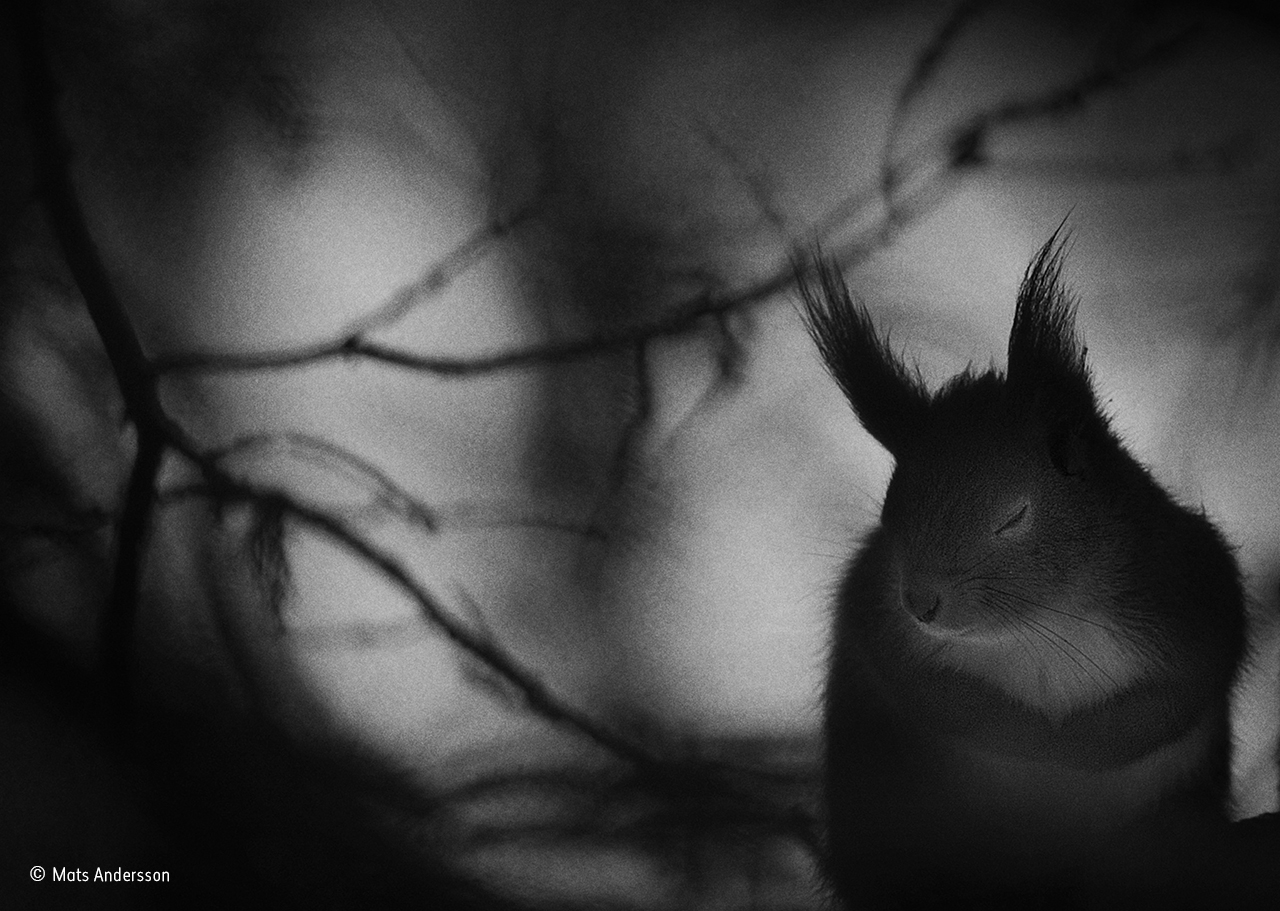
Winter pause
Mats Andersson, Sweden
Finalist 2017,Black and White
The red squirrel closed its eyes for just a moment, paws together, fur fluffed, then resumed its search for food. Winter is atough time for northern animals.Some hibernate to escape its rigours, but not red squirrels. Mats walks every day in the forest near his home in southern Sweden, often stopping to watch the squirrels foraging in the spruce trees. Though their mainly vegetarian diet is varied, their winter survival is linked to a good crop of spruce cones, and they favour woodland with conifers. Theyalso store food to helpsee them through lean
page 4of 5times. On this cold, February morning, the squirrel’s demeanourencapsulated the spirit of winter, captured by Mats using the soft-light grain of black and white.
Equipment: Nikon D3 + 300mm f2.8 lens; 1/320 sec at f2.8; ISO 800.
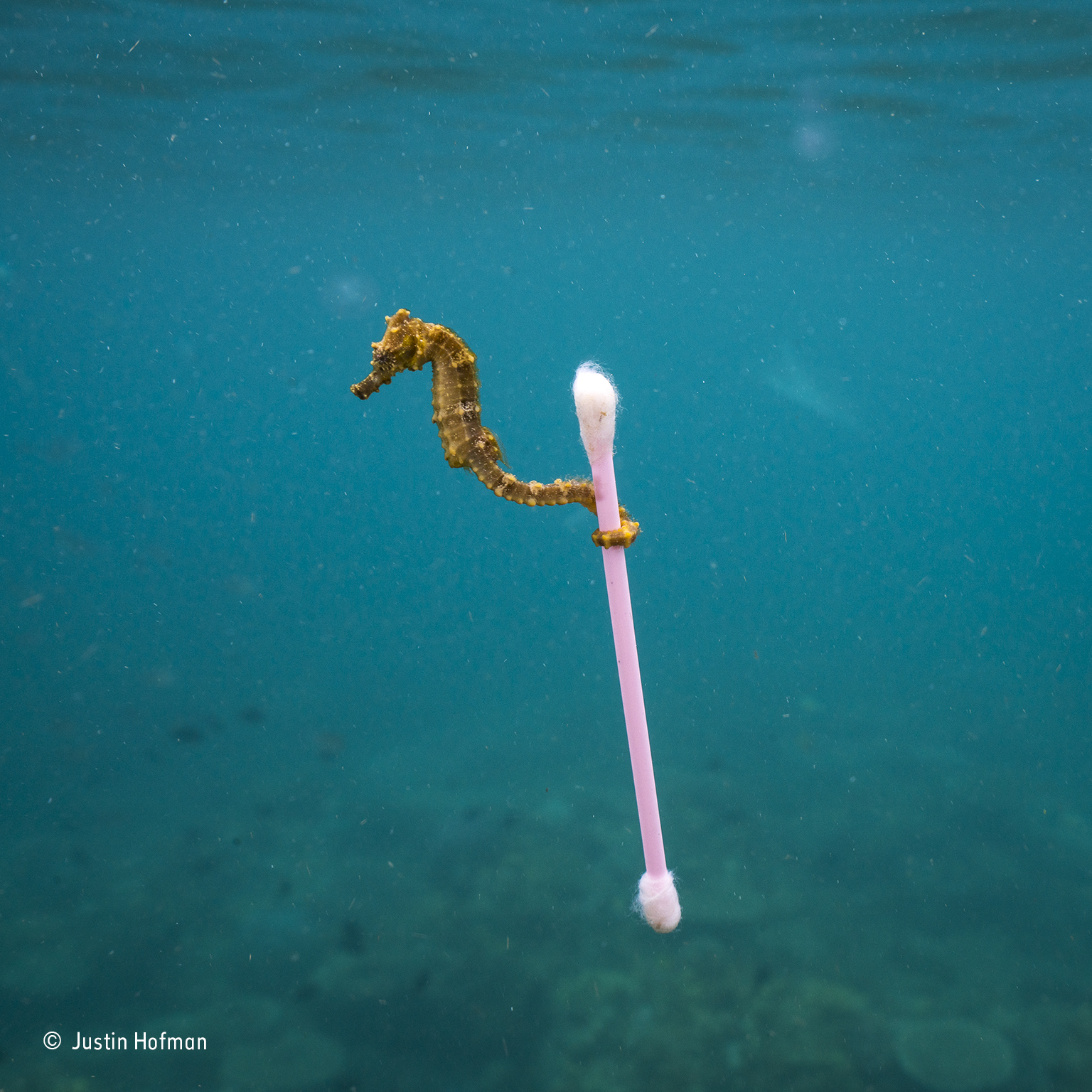
Sewage surfer
Photographer: Justin Hofman, USA
Finalist 2017, The Wildlife Photojournalist Award: Single Image Seahorses hitch rides on the currents by grabbing floating objects such as seaweed with their delicate prehensile tails. Justin watched with delight as this tiny estuary seahorse ‘almost hopped’ from one bit of bouncing natural debris to the next, bobbing around near the surface on a reef near Sumbawa Island, Indonesia. But as the tide started to come in, the mood changed. The water contained more and more decidedly unnatural objects –mainly bits of plastic –and a film of sewage sludge covered the surface, all sluicing towards the shore. The seahorse let go of a piece of seagrass and seized a long, wispy piece of clear plastic. As a brisk wind at the surface picked up, making conditions bumpier, the seahorse took advantage of something that offered a more stable raft: a waterlogged plastic cottonbud. Not having a macro lens for the shot ended up being fortuitous, both because of the strengthening current and because it meant that Justin decided to frame the whole scene, sewage bits and all. As Justin, the seahorse and the cottonbud spun through the ocean together, waves splashed into Justin’s snorkel. The next day, he fell ill. Indonesia has the world’s highest levels of marine biodiversity but is second only to China as a contributor to marine plastic debris –debris forecast to outweigh fish in the ocean by 2050. On the other hand, Indonesia has pledged to reduce by 70 per cent the amount of waste it discharges into the ocean.
Equipment: Sony Alpha 7R II + 16–35mm f4 lens; 1/60 sec at f16; ISO 320; Nauticam housing + Zen 230mm Nauticam N120 Superdome; two Sea & Sea strobes with electronic sync.
Exhibition information Dates and times:
Friday 20 October 2017 –spring 201810.00–17.50 (last admission 17.15)
To book tickets: www.nhm.ac.uk/wpy
Facebook: www.facebook.com/wildlifephotographeroftheyear
Twitter: @NHM_WPYInstagram: @nhm_wpy
* Online booking prices including optional Gift Aid donation to the Museum.
The next Wildlife Photographer of the Year competition, #WPY54, will be open for entries from 23October to 14 December2017. http://www.nhm.ac.uk/visit/wpy/competition.html
